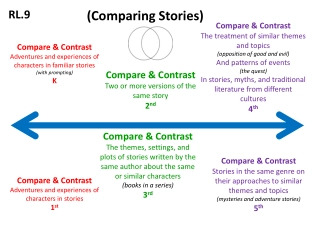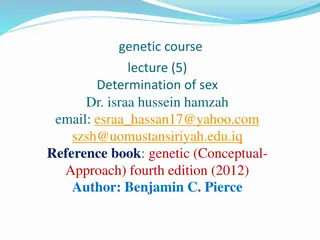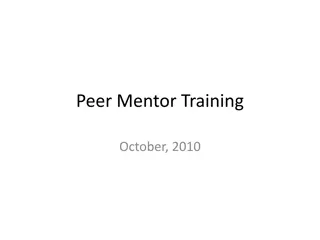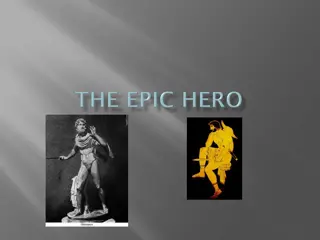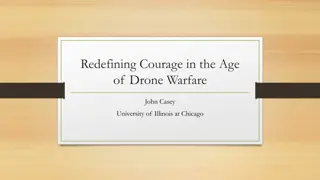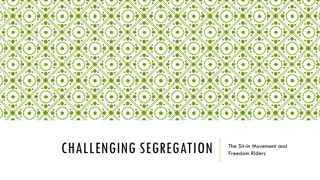Uplifting Stories of Courage and Determination
Explore the powerful accounts of individuals like Alexandra Deford, the first African-American soloist at the Metropolitan Opera, and Melba Pattillo, a civil rights pioneer. These stories showcase resilience, bravery, and the strength to overcome adversity, inspiring readers to find their own courage in challenging times.
Download Presentation

Please find below an Image/Link to download the presentation.
The content on the website is provided AS IS for your information and personal use only. It may not be sold, licensed, or shared on other websites without obtaining consent from the author.If you encounter any issues during the download, it is possible that the publisher has removed the file from their server.
You are allowed to download the files provided on this website for personal or commercial use, subject to the condition that they are used lawfully. All files are the property of their respective owners.
The content on the website is provided AS IS for your information and personal use only. It may not be sold, licensed, or shared on other websites without obtaining consent from the author.
E N D
Presentation Transcript
Alexandra Deford, a precious and precocious girl, was just eight years old when she died in 1980 following a battle against the debilitating effects of cystic fibrosis, the number-one genetic killer of children. Her poignant and uplifting story touched the hearts of millions when it was first published and then made into a memorable television movie. A new introduction contains information on the latest cystic fibrosis research, and a touching postscript reveals how the Deford family came to terms with the loss of Alex. Whenever he speaks, sportswriter Frank Deford knows people will bring articles for him to sign. But what makes him happiest is when someone attends a sports-oriented lecture and brings a copy of Alex: The Life of a Child for him to sign. "Invariably, and happily, there's usually someone at each appearance who either brings that book or wants to talk about their connection to cystic fibrosis." Deford says.
A biography of the opera and concert singer who, among other achievements, was the first African- American soloist to perform with the Metropolitan Opera Company in 1955.
Abigail Adams is often referred to as the wife of one president and the mother of another. Rarely is she described as a woman in her own right. Although her primary focus and concerns were in her role as wife and mother, she lives in history because of her extraordinary letters to her family and to her friends. She was a witness to the gathering storm of the Revolutionary War. She saw the Battle of Bunker Hill from a hilltop near her home, and soldiers marching past her door frequently stopped for a drink of water. Because she was so close to the scene, she was able to give firsthand reports of the American Revolution to her husband and other leaders creating a new government, as she wrote about the times and the people who played vital roles in the birth of our nation.
You've gotta learn to defend yourself. Never let your enemy know what you are feeling. The soldier assigned to protect Melba Please, God, let me learn how to stop being a warrior. Sometimes I just need to be a girl. Melba's diary, on her sixteenth birthday. In 1957 Melba Pattillo turned sixteen. That was also the year she became a warrior on the front lines of a civil rights firestorm. Following the landmark 1954 Supreme Court ruling, Brown v. Board Education. She was one of nine teenagers chosen to integrate Little Rock's Central High School. This is her remarkable story. You will listen to the cruel taunts of her schoolmates and their parents. You will run with her from the threat of a lynch mob's rope. You will share her terror as she dodges lighted sticks of dynamite, and her pain as she washes away the acid sprayed into her eyes. But most of all you will share Melba's dignity and courage as she refuses to back down.
Father Greg Boyle, one of the few people who don't write off homies as unredeemable souls, attracted intense media attention in 1992 for his perseverance in turning gangbangers around. Fremon was a reporter entirely captivated by Boyle's charisma and commitment, and she decided to immerse herself in Boyle's barrio parish, where the nihilistic credo of kill or be killed holds sway, though it was somewhat restrained by Boyle's hands-on intervention. In her chronicle of Boyle's zealous efforts at fundraising and organizing to find jobs for the homeboys, Fremon inserts about ten of their autobiographies. Subsequently, one of the homies was murdered in gang vengeance. The consequent brokenness of the text, punctuated by Father Boyle's empathic heroism, suitably reflects the jagged violence it depicts. This is a heartfelt study of the gangland culture and a tribute to a man who has had a measure of success redeeming some of its members.
Paul William "Bear" Bryant (September 11, 1913 January 26, 1983) was an American college football player and coach. He was best known as the longtime head coach of the University of Alabama football team. During his 25-year tenure as Alabama's head coach, he amassed six national championships and thirteen conference championships. Upon his retirement in 1982, he held the record for most wins as head coach in collegiate football history with 323 wins. At the University of Alabama, the Paul W. Bryant Museum, Paul W. Bryant Hall, Paul W. Bryant Drive and Bryant Denny Stadium are all named in his honor. He was also known for his trademark black and white houndstooth or gingham hat, deep voice, casually leaning up against the goal post during pre-game warmups, and frequently holding his rolled-up game plan while on the sidelines.
"When it comes to justice, there is no easy way to get it. You can't sugarcoat it. You have to take a stand and say, ,This is not right.'" - Claudette Colvin On March 2, 1955, an impassioned teenager, fed up with the daily injustices of Jim Crow segregation, refused to give her seat to a white woman on a segregated bus in Montgomery, Alabama. Instead of being celebrated as Rosa Parks would be just nine months later, fifteen-year-old Claudette Colvin found herself shunned by her classmates and dismissed by community leaders. Undaunted, a year later she dared to challenge segregation again as a key plaintiff in Browder v. Gayle , the landmark case that struck down the segregation laws of Montgomery and swept away the legal underpinnings of the Jim Crow South
Ironically, this internationally known author of children's books struggled to learn how to read when she entered school. Before long however Cleary had learned to love books, and as a child she spent a good deal of her time in the public library. Cleary earned her first B.A. in 1938 from the University of California at Berkeley. Her second degree, a B.A. in library science, was bestowed by the University of Washington in Seattle in 1939. She worked for a short time as Children's Librarian in Yakima, Washington, before moving to California. Cleary began her writing career in her early thirties. Her stories and especially her characters, Henry Huggins and Ramona Quimby, have proven popular with young readers. Her books have been translated into fourteen languages and are available in over twenty countries.
Victor Cruz, the Super Bowl-winning and record-breaking wide receiver, is best known for his explosive plays and salsa touchdown celebrations. While his meteoric rise in the NFL looked like the result of a magical year, it was actually a lifetime in the making. Raised in Paterson, New Jersey, Victor overcame numerous setbacks through hard work, perseverance, and the support of his loving family#151;from his grandmother who gave him his signature dance moves; to his late father, a former firefighter, who introduced him to football and taught him how to play; to his hard-working, single mother who never let him give up in the face of a challenge. They all helped to keep him on the right path, as did his coaches, but Cruz's journey was never easy. There were academic struggles, injuries, and more. In this inspiring, never- before-seen account, Cruz pays tribute to the people and places that made him the man he is today, recounts his most defining moments, and illustrates how his hardships ultimately unleashed his impenetrable will to win
This is the inspiring story of how knuckleballer R. A. Dickey became one of the game's best pitchers. He had humble beginnings, and as a child kept a terrible secret. But at a local prep school, coaches saw talent in him and fostered his skills as a player. Dickey went on to pitch in the Olympics while at the University of Tennessee, but his Major League hopes took a downturn when an X-ray revealed a major problem with his throwing arm. It would seem his future in baseball was over before it even began. But R.A. knew better. Through faith, hope, and determination, he achieved his dreams and made it into the major leagues. Now, he's one of the most respected pitchers in the game, a Cy Young Award winner, and he's changed the way people view the knuckleball - and himself. An inspiring true story about beating the odds, R.A. is proof that with hard work and devotion, anyone can overcome whatever life throws at them.
The thrilling story of America's most celebrated flyer, Amelia Earhart. In alternating chapters, Fleming deftly moves readers back and forth between Amelia's life (from childhood up until her last flight) and the exhaustive search for her and her missing plane. With incredible photos, maps, and handwritten notes from Amelia herself- -plus informative sidebars tackling everything from the history of flight to what Amelia liked to eat while flying (tomato soup)--this unique nonfiction title is tailor-made for middle graders. Amelia Lost received four starred reviews and Best Book of the Year accolades from School Library Journal , Kirkus Reviews , Horn Book Magazine , the Washington Post , and the New York Times .
This is the memoir of Esther Earl, a 16- year-old who suffered from terminal thyroid cancer that metastasized in her lungs. She was an inspiration for John Green's The Fault in Our Stars. Esther kept incredible notes from when she was 10 until her untimely passing at age 16. Her fears, wishes, anxieties are all revealed with incredible sincerity and depth. Esther was an amazing person and wanted everyone to share love. She wanted to be treated as a regular person, without "cancer perks." The audio version is so moving that some listeners may want to start over from the beginning as soon as they finish.
Goldberg not only recounts the important aspects of Einstein's background, family, and accomplishments, but also explains the scientist's major theories. Using well-placed chapter inserts and diagrams, the author explicates difficult concepts such as the "Principle of Equivalence," "Time Dilation," and "Origins of the Quantum Hypothesis," and does a masterful job of showing how Einstein's theories vary from those of other learned theoreticians, such as Planck and Bohr. Yet readers are told that Einstein's own wife never really understood his groundbreaking ideas, and without extensive scientific background, many students will have a tough time grasping the theories, even when they are explained as clearly as they are here.
At age 11, Brooke Ellison was left paralyzed from the neck down after being hit by an automobile. Writing together in alternating chapters, Brooke and her mother, Jean, document the exhausting efforts and dedication that it took for Brooke to beat overwhelming physical odds and finally graduate, with honors, from Harvard University. The story begins on the day of the accident and ends triumphantly with Brooke's graduation speech from college. Brooke's upbeat account of her college experience reveals her charming and witty nature, and Jean's contribution is a testimony to the profound powers of a mother's love and unfailing dedication. Although many other biographies of quadriplegics are available, this one, written with keen intellect and an open heart, deserves attention.
In this brilliantly researched and insightful book, psychologist Eva Fogelman presents compelling stories of rescuers of Jews during the Holocaust-- and offers a revealing analysis of their motivations. Based on her extensive experience as a therapist treating Jewish survivors of the Holocaust and those who helped them, Fogelman delves into the psychology of altruism, illuminating why these rescuers chose to act while others simply stood by. While analyzing motivations, Conscience And Courage tells the stories of such little-known individuals as Stefnaia Podgorska Burzminska, a Polish teenager who hid thirteen Jews in her home; Alexander Roslan, a dealer in the black market who kept uprooting his family to shelter three Jewish children in his care, as well as more heralded individuals such as Oskar Schindler, Raoul Wallenberg, and Miep Gies. Speaking to the same audience that flocked to Steven Spielberg's Academy Award-winning movie, Schindler's List, Conscience And Courage is the first book to go beyond the stories to answer the question:
Most people are familiar with the story of Anne Frank and her diary composed as she and her Jewish family hid from Nazis for several years in an office building in the heart of Amsterdam. Now comes another side of the story, that of the woman who bravely served as the Franks' mainstay as they hid, even though she expected certain death if caught. Although the Franks were eventually found and arrested, Miep fortunately was not taken, and she saved Anne's diary, a message for posterity.
A funny, highly personal, gorgeously written account of what it's like to be a 30-year-old man who is told he has an 80-year-old's disease. "Life is great. Sometimes, though, you just have to put up with a little more crap." --Michael J. Fox In September 1998, Michael J. Fox stunned the world by announcing he had been diagnosed with Parkinson's disease--a degenerative neurological condition. In fact, he had been secretly fighting it for seven years. The worldwide response was staggering. Fortunately, he had accepted the diagnosis and by the time the public started grieving for him, he had stopped grieving for himself. Now, with the same passion, humor, and energy that Fox has invested in his dozens of performances over the last 18 years, he tells the story of his life, his career, and his campaign to find a cure for Parkinson's.
Temple Grandin was born August 29, 1947 in Boston, Massachusetts. She is a bestselling author, doctor and professor of Animal Science at Colorado State University, and leader of both the animal welfare and autism advocacy movements. Grandin was diagnosed with autism in 1950. She was immediately placed in a structured nursery, had speech therapy, and had a nanny spend hours playing turn-based games with her. At the age of four, she began talking and her progress continued. In 1970, Grandin received her bachelor's degree in psychology from Franklin Pierce College in Rindge, New Hampshire. She received her master's degree in animal science from Arizona State University in 1975, and in 1989, she received a Ph.D. in animal science from the University of Illinois at Urbana- Champaign. Grandin, being a high-functioning autistic, is widely-known for her work in autism advocacy.
When Temple Grandin was born, her parents knew that she was different. Years later she was diagnosed with autism. While Temple's doctor recommended a hospital, her mother believed in her. Temple went to school instead. Today, Dr. Temple Grandin is a scientist and professor of animal science at Colorado State University. Her world-changing career revolutionized the livestock industry. As an advocate for autism, Temple uses her experience as an example of the unique contributions that autistic people can make. This compelling biography complete with Temple's personal photos takes us inside her extraordinary mind and opens the door to a broader understanding of autism.
Jane Goodall, 1934 - Jane Goodall, a well-respected English zoologist, is famous for her fieldwork with chimpanzees in Africa. An early interest in African wild animals and the opportunity, at age 18, to stay on a friend's farm in Kenya, led her to Dr. Louis Leakey; then curator of the National Museum of Natural History in Nairobi. Almost immediately Leakey hired Goodall as his assistant secretary, and she was soon accompanying Leakey and his wife on their expeditions. Following Leakey's suggestion that a field study of some of the higher primates would be a major contribution to the understanding of animal behavior, she began studying the chimpanzees of the Gombe Stream Research Center in Tanganyika (now Tanzania) in 1960. Although she had no undergraduate degree, Goodall earned a Ph.D. from Cambridge University in 1965, based on her first five years of research at the Gombe Center. After more than 20 years of extensive study and direct contact with wild chimpanzees in their natural habitat, Goodall continues to research, teach, and write about primate behavior today.
Hamilton, a 14-year-old aspiring professional surfer from Kauai, Hawaii, made headlines last fall after she lost her arm in a shark attack. With the help of writer Berk and Bundschuh, a pastor whom the teen calls her "spiritual advisor," the teen offers an upbeat and candid-if somewhat meandering-chronicle of her life. She opens with the shark attack, then fills in details before and after this tragic incident, giving priority to the topics pinpointed in the book's subtitle. Her fervent faith surfaces often in her account: her church youth group figures prominently in her life, she prays before each surfing competition, she states that "Being tight with God is even more important to me than surfing" and, in discussing "God's plan" for her, states, "if I can help other people find hope in God, then that is worth losing my arm for." Hamilton offers copious background information about her close- knit family and her passion for surfing, as well as expressions of gratitude for the post-attack outpouring of support and donations from friends and strangers.
For the more than seven million girls--from knobby-kneed tykes to high school and college stars--who are tearing across the country chasing a soccer ball and dreams of glory, there is one name that eclipses all others, male or female: Mia Hamm. With her cheetah like acceleration and lightning- bolt shot, Hamm broke nearly every record in her sport, while galvanizing a whole generation of fans and players. Go for the Goal is not only the inspiring story of how a tiny suburban sprite became a global terror with a ball (and the world) at her feet--it's also a step-by-step or dribble-by-dribble guide for any kid with the all-American dream of making the team and becoming a champion.
Who was this man who could walk through brick walls and, with a snap of his fingers, vanish elephants? In these pages you will meet the astonishing Houdini-magician, ghost chaser, daredevil, pioneer aviator, and king of escape artists. No jail cell or straitjacket could hold him! He shucked off handcuffs as easily as gloves. In this fresh, witty biography of the most famous bamboozler since Merlin, Sid Fleischman, a former professional magician, enriches his warm homage with insider information and unmasking. Did Houdini really pick the jailhouse lock to let a fellow circus performer escape? Were his secrets really buried with him? Was he a bum magician, as some rivals claimed? How did he manage to be born in two cities, in two countries, on two continents at the same instant? Here are the stories of how a knockabout kid named Ehrich Weiss, the son of an impoverished rabbi, presto-changoed himself into the legendary Harry Houdini.
Born a spastic quadriplegic, Rick Hoyt was written off by numerous doctors, but his parents, Dick and Judy Hoyt, were determined to give their son all the opportunities of a normal kid.In 1977, fifteen-year-old Rick asked his dad to enter a charity race. The twist? Rick wanted to run it too. Dick had never run a race before, and the thought of pushing his son s wheelchair while running was daunting. But, once again, Dick and Rick were determined to overcome any obstacle. More than one thousand races later, the devoted father son duo is affectionately known worldwide as Team Hoyt and continue to move people with their trademark motto: Yes, you can.
Bill Gates is many things: the richest person in the world; the ruthless businessman who co-founded Microsoft and led it to domination of the computer software industry; and now, the leading global philanthropist. When Gates was born in 1955, no one in the world owned a personal computer. A window had a pane of glass. A mouse was a rodent. As a teenager, Gates realized how computers were about to change the world, and made his fortune by riding that wave; modern teens look to him as their model of how technology can be turned into wealth.
"Your time is limited. . . . have the courage to follow your heart and intuition." -Steve Jobs. From the start, his path was never predictable. Steve Jobs was given up for adoption at birth, dropped out of college after one semester, and at the age of twenty, created Apple in his parents' garage with his friend Steve Wozniack. Then came the core and hallmark of his genius - his exacting moderation for perfection, his counterculture life approach, and his level of taste and style that pushed all boundaries. A devoted husband, father, and Buddhist, he battled cancer for over a decade, became the ultimate CEO, and made the world want every product he touched. Critically acclaimed author Karen Blumenthal takes us to the core of this complicated and legendary man while simultaneously exploring the evolution of computers.
Thought-provoking and profoundly satisfying, this book will inspire feelings of humility, admiration, and disquietude; in some readers, it may sow the seeds of humanitarian activism. As a specialist in infectious diseases, Farmer's goal is nothing less than redressing the "steep gradient of inequality" in medical service to the desperately poor. His work establishing a complex of public health facilities on the central plateau of Haiti forms the keystone to efforts that now encompass initiatives on three continents. Farmer and a trio of friends began in the 1980s by creating a charitable foundation called Partners in Health (PIH, or Zanmi Lasante in Creole), armed with passionate conviction and $1 million in seed money from a Boston philanthropist. Kidder provides anecdotal evidence that their early approach to acquiring resources for the Haitian project at times involved a Robin Hood type of "redistributive justice" by liberating medical equipment from the "rich" (Harvard) and giving to the "poor" (the PIH clinic).
In this compelling memoir, the 64-year-old founder of Susan G. Komen for the Cure mixes details from her soap opera-like life with facts about breast cancer. Nancy Goodman of Peoria, Illinois, morphs from a chubby Jewish girl (in second grade, she tips the scale at more than 100 pounds) to a nearly six-foot glamazon. After breast cancer kills her beautiful 36-year-old sister, Suzy, Nancy starts the world's largest breast-cancer charity in her memory. At age 37, she discovers a lump in her own chest. Nancy gets by with a little help from her second husband, Norman Brinker, the casual-dining gazillionaire and a member of the Susan G. Komen board from its inception in 1982 until his death last year.
Aung San Suu Kyi returned to Burma in 1988, after years living and studying abroad, only to find widespread slaughter of protesters rallying against the brutal rule of dictator U Ne Win. She spoke out against him and initiated a nonviolent movement toward achieving democracy and human rights. In 1989, the government placed Suu Kyi under house arrest, and she spent 15 of the next 21 years in custody. In 1991, her ongoing efforts won her the Nobel Prize for Peace, and she was finally released from house arrest in November 2010
Jason Lester's life as an athlete almost never happened. When a speeding car ran a red light, a bike ride to the local video store nearly became Jason's last, sending him 130 feet into the air and ultimately to the hospital with twenty broken bones. The pain was intense and long rehabilitation grueling, compounded by the sudden death of his father (his best friend and mentor) and the realization that his right arm was paralyzed. Only twelve years old and struggling to heal amid the grief, Jason miraculously found the strength to fight his way back. Without the use of his arm, he refused to give up the sports he'd grown to love, recommitting himself to life and ultimately surpassing goals that few dared to set. Running on Faith reveals how to develop the mind-set of a true competitor and includes riveting stories of the precarious and often unforeseen conditions encountered on the race path--jellyfish-infested waters, suffocating heat, and blinding sheets of rain. With passion, dedication, and strength of purpose, Jason shares his experience facing extreme challenges head-on, gleaning insight from each trial.
Carson, director of the Martin Luther King Jr. Papers Project, brings together selections from King's writings, speeches, and recordings to create this fascinating "autobiography" of the famed civil rights leader and Nobel Peace Prize winner. The writings trace King's struggles with religion, philosophy, and the racial politics of the U.S. They reveal his youthful attraction to Henry David Thoreau's stance on the moral obligation to resist evil as much as to cooperate with good, and Mahatma Gandhi's teachings on nonviolent resistance to oppression. This work offers King's view on a number of thorny issues; on Rosa Parks and the bus boycott in Birmingham that launched the civil rights movement, for example, King characterizes her actions as spontaneous rather than planned, which has been suggested. He contrasts the racial milieu and tactics needed to address racism in the North versus the South and sees the Civil Rights Act of 1964, the culmination of the nonviolent resistance movement, as "first written in the streets" with the success of the protest marches. This stunning, passionate collection of writings also reveals King's impressions of other famous leaders of the time, including presidents John Kennedy and Lyndon Johnson and activists Stokely Carmichael and Malcolm X.
Nelson Mandela, who emerged from twenty-six years of political imprisonment to lead South Africa out of apartheid and into democracy, is perhaps the world's most admired leader, a man whose life has been led with exemplary courage and inspired conviction. Now Anthony Sampson, who has known Mandela since 1951 and has been a close observer of South Africa's political life for the last fifty years, has produced the first authorized biography, the most informed and comprehensive portrait to date of a man whose dazzling image has been difficult to penetrate. With unprecedented access to Mandela's private papers (including his prison memoir, long thought to have been lost), meticulous research, and hundreds of interviews-- from Mandela himself to prison warders on Robben Island, from Walter Sisulu and Oliver Tambo to Winnie Mandela and F. W. de Klerk, and many others intimately connected to Mandela's story--Sampson has composed an enlightening and necessary story of the man behind the myth.
Award-winning author Andrea Warren presents a life-changing story of a young boy's struggle for survival in a Nazi-run concentration camp. In this Robert F. Silbert Honor Book, narrated in the voice of Holocaust survivor Jack Mandelbaum, readers will glimpse the dark reality of life during the Holocaust, and how one boy made it out alive. When twelve-year-old Jack Mandelbaum is separated from his family and shipped off to the Blechhammer concentration camp, his life becomes a never-ending nightmare. With minimal food to eat and harsh living conditions threatening his health, Jack manages to survive by thinking of his family. Supports the Common Core State Standards
Kaffir Boy (1984), one of the best books ever written about apartheid, became a bestseller everywhere but in South Africa, where it is banned. This absorbing sequel, about Mathabane's life in the U.S. since he arrived here at age 18 in 1978 on a tennis scholarship, describes his painful experiences at three colleges in one year and in American society generally. He recalls his editorship of a college paper, disenchantment with the Columbia School of Journalism, encounters with racism, threats to his life, living on a shoestring budget, speaking out against racism, his decisions to become a writer, live in North Carolina and marry a white woman, his success (with Oprah Winfrey's help) in bringing members of his family on a visit to America and in arranging for some of his siblings to remain here to study. Mathabane is a remarkable human being: responsible, committed, reasonable, level-headed, humane, understanding and empathetic. He tells a wonderful, inspiring story and he tells it well.
Breaking Night is the stunning memoir of a young woman who at age fifteen was living on the streets, and who eventually made it into Harvard. Liz Murray was born to loving but drug-addicted parents in the Bronx. In school she was taunted for her dirty clothing and lice-infested hair, eventually skipping so many classes that she was put into a girls' home. At age fifteen, Liz found herself on the streets when her family finally unraveled. She learned to scrape by, foraging for food and riding subways all night to have a warm place to sleep. When Liz's mother died of AIDS, she decided to take control of her own destiny and go back to high school, often completing her assignments in the hallways and subway stations where she slept. Liz squeezed four years of high school into two, while homeless; won a New York Times scholarship; and made it into the Ivy League. Breaking Night is an unforgettable and beautifully written story of one young woman's indomitable spirit to survive and prevail, against all odds.
She was a reluctant feminist. She took on the most unfeminine of skills--competitive shooting- -yet very much prided herself on being a lady. Although she proclaimed that a woman could do anything a man could and probably do it better, she refused to align herself with the women's movement of her day. She was so famous that she has now entered folk history as sort of an icon of the Wild West, yet she started out a poor, abused child. Kasper's book on Annie Oakley captures these contradictions in telling her life story. Rich with detail, rife with anecdote, it not only paints a picture of a woman with an unusual occupation for her time, it also colors the whole era of Wild West performers from Buffalo Bill to Will Rogers.
Michael Ohers positive story has been a welcome respite from all the reported poor behavior by professional football players over the years. Now here is Oher's opportunity, with Yaeger (former associate editor, Sports Illustrated), to tell his side of the story, which is especially distinct from the movie, in which a lot of the real details were left out while other circumstances were exaggerated to make the story more dramatic. For example, in the movie Oher was a football novice with difficulty learning plays; in actuality, as Oher reminds us here, he had been playing for years and knew the game very well by the time he met the Touhys. Verdict Recommended. A corrective to the movie, yet still an inspirational book for fans of Oher and the Touhys.
Schaap's chronicle of Jesse Owens's journey to and glorious triumph at the 1936 Berlin Olympics is snappy and dramatic, with an eye for the rousing climax, through curiously slight on follow-through. Starting with Owens as the well-feted ex-athlete in the 1950s, Schaap (an ESPN anchor and author of Cinderella Man) flashes back to Owens's childhood in 1920s Cleveland, where junior high coach Charles Riley spotted his astounding physique and near limitless potential for track and field. Owens seems so perfectly made for running and jumping that the following years of ever-increasing athletic and popular success are less exciting than preordained. By the time the "Ebony Antelope" (as one of many adoring newspapermen had anointed him) was ready for Berlin, his success was practically guaranteed. The real drama of Schaap's book, which surprisingly skimps on Owens the person, comes in the politically fractious run-up to Berlin (for the ceremony-obsessed Hitler, "a fascist fantasy come true").
In this fascinating, suspenseful first person account of his capture by Somali pirates, which dominated news media for five days in April 2009, captain Phillips brings the growing pirate threat (up 20 percent in 2009's first quarter) to life. An experienced Merchant Marine, Phillips was recently made captain of the cargo vessel Maersk Alabama, and, like all captains, was weary of the threat from pirates: "since 2005. captains had been going out fifty, then one hundred. then six hundred miles" to avoid the Somali coast. His feeling that "if pirates got onboard, it was all over" proves unfortunately correct; it took the armed criminals just five minutes to board the ship and take the bridge. Phillips has a sailor's penchant for the dramatic, which he puts to good use alternating between his own five-day ordeal-replete with Navy SEALs and a daring escape attempt-and the plight of his family in Vermont, watching the drama unfold on cable news. Despite his harrowing experience, Phillips stays afloat with steadfast faith and an unfailing sense of humor that are, ultimately, rewarded. Phillips's story is not just riveting and timely, but also an informative, heartening look at perhaps the least-celebrated branch of the U.S. military, the Merchant Marines.
The whole world held its breath when Christopher Reeve struggled for life on Memorial Day, 1995. On the third jump of a riding competition, Reeve was thrown headfirst from his horse in an accident that broke his neck and left him unable to move or breathe. In the years since then, Reeve has not only survived, but has fought for himself, for his family, and for the hundreds of thousands of people with spinal cord injuries in the United States and around the world. And he has written Still Me , the heartbreaking, funny, courageous, and hopeful story of his life.
The Autobiography of a Boy of Summer Who Became a Man for All Seasons Before Barry Bonds, before Reggie Jackson, before Hank Aaron, baseball's stars had one undeniable trait in common: they were all white. In 1947, Jackie Robinson broke that barrier, striking a crucial blow for racial equality and changing the world of sports forever. I Never Had It Made is Robinson's own candid, hard-hitting account of what it took to become the first black man in history to play in the major leagues.
"For forty years, Fred Rogers has been telling children and the rest of us that he likes us just the way we are. No one else in our lives gives us that message. Now, in Mister Rogers' Neighborhood, fifteen essayists show how deeply, and in how many ways, the message has registered. Starting with satirist Bob Garfield's hilarious conversion from Rogers Rejectionism to Rogers Rebirth, through cellist YoYo Ma's respect for Fred's musical messages, through various Fredwatchers' reactions to the depth and honesty of his work, this collection is a reminder of the many and varied lives Fred Rogers has touched, kept sane, kept steady and centered. The book is testimony to this fact: after two score years on television, Fred Rogers remains the best friend America's families ever had."
Jordan Romero climbed Mount Everest at age thirteen-and he didn't stop there. In this inspiring young adult memoir, he tells how he achieved such great heights. On May 22, 2010, at the age of thirteen, American teenager Jordan Romero became the youngest person to climb to the summit of Mount Everest. At fifteen, he became the youngest person to reach the summits of the tallest mountains on each of the seven continents. In this energizing memoir for young adults, Jordan, now seventeen, recounts his experience, which started as a spark of an idea at the age of nine and, many years of training and hard work later, turned into a dream come true.
The story of TR, a New York aristocrat and prominent Republican whose strong will and likeable, robust personality combined to get him elected to two terms as president of the United States. After holding various important positions, including secretary of the Navy, Governor of New York, and vice president of the United States, he became president in 1901. Rancher, writer, conservationist, and leader of the Rough Riders in the Spanish-American War, Roosevelt led an exciting life that Meltzer makes jump off the pages.
Convinced that what she wanted from life could only be attained by "the opportunity for doing something useful," Eleanor seized every chance afforded her by her position as wife of the president to work for peace and prosperity both at home and overseas.
This is the definitive biography of the worlds most famous writer. J.K. Rowling's meteoric rise to worldwide superstardom and bestseller status is now the stuff of tabloid legend how, as a single mother, she would spend hours in a cafe in Edinburgh, nursing a single coffee and a glass of water while she wrote the first Harry Potter novel that would bring her fame and fortune. Creator of the most famous and best-loved character in contemporary fiction, J.K. Rowling is also the author of her own escape from an unhappy marriage and a depressing existence on the verge of destitution. The acclaimed celebrity biographer Sean Smith goes behind the headlines and hype to trace the life story of this phenomenal woman who has brought joy and inspiration to millions of readers around the world. He also reveals many of the sources and origins of the books drawn from her early life.
The Olympic gold medalist and starting goalkeeper for the U.S. women's national soccer team gives readers behind-the- scenes details of her life on and off the field. Solo offers a fearless female role model for the next generation, driven to succeed on her own terms. Young fans will truly be inspired by Hope's repeated triumphs over adversity. Her relentless spirit has molded her into the person she is today--one of the most charismatic athletes in America. A huge player in the Summer 2012 Olympic Games, Hope shares her inside story in her own words.
In May 2002, Tillman walked away from his $3.6 million NFL contract to enlist in the United States Army. He was deeply troubled by 9/11, and he felt a strong moral obligation to join the fight against al- Qaeda and the Taliban. Two years later, he died on a desolate hillside in southeastern Afghanistan. Though obvious to most of the two dozen soldiers on the scene that a ranger in Tillman's own platoon had fired the fatal shots, the Army aggressively maneuvered to keep this information from Tillman's wife, other family members, and the American public for five weeks following his death. During this time, President Bush repeatedly invoked Tillman's name to promote his administration's foreign policy. Long after Tillman's nationally televised memorial service, the Army grudgingly notified his closest relatives that he had "probably" been killed by friendly fire while it continued to dissemble about the details of his death and who was responsible.
Thorpe spent his life running-running away from school, running on the baseball diamond, running the football, or running to win both the pentathlon and the decathlon in the 1912 Olympics in Stockholm. His accomplishments, his kindness and consideration of others, his defeats, and his exploitation are related in first-person narration, from his childhood on an Oklahoma reservation to the loss of his Olympic medals for playing on a professional minor-league baseball team. Readers learn about his athletic performances (some related play by play), his triumphs, his friendships, and his hardships through the use of dialogue and description. The trust that Thorpe had in others and his own perseverance show both his personal weaknesses and strengths.


